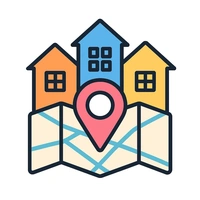
Neighborhood Guide in Lhasa, China
1. Potala Palace
Iconic 17th-century palace of the Dalai Lama, offering stunning views of Lhasa and its surrounding mountains.
- Historical Significance: Home to successive Dalai Lamas for centuries.
- Architectural Marvel: A unique blend of Tibetan and Nepalese architecture.
- Museum Inside: Includes various cultural artifacts, statues, and thangkas (Tibetan scroll paintings).
2. Jokhang Temple
Sacred Buddhist temple in the heart of Lhasa, housing a Jowo Rinpung statue of the young Buddha.
- Spiritual Significance: One of the most revered temples in Tibet.
- Cultural Experience: Visitors can witness local pilgrims circumambulating the temple.
- Intricate Architecture: A beautiful example of Tibetan architecture with golden roofs and vibrant murals.
3. Barkhor Street
Busy market street surrounding the Jokhang Temple, filled with traditional Tibetan shops.
- Shopping Paradise: Offers a wide variety of Tibetan handicrafts, souvenirs, and local delicacies.
- Cultural Immersion: A great place to interact with locals and learn about their culture.
- Architectural Sightseeing: Features many old Tibetan buildings and monasteries.
4. Norbulingka Palace
Summer residence of the Dalai Lamas since the 18th century, with beautiful gardens and traditional Tibetan architecture.
- Historic Significance: Has been the summer retreat for successive Dalai Lamas.
- Natural Beauty: Surrounded by lush green gardens and pine trees.
- Cultural Insight: Contains a traditional Tibetan theatre, museum, and library.
5. Sera Monastery
One of the great Gelug monasteries founded in 1419, known for its monks' debating sessions.
- Religious Education: Monks engage in public debates on Buddhist philosophy daily.
- Architectural Beauty: Features whitewashed buildings with golden roofs and beautiful murals.
- Historical Insight: Contains numerous temples, halls, and the tombs of former abbots.
6. Drepung Monastery
One of the largest monasteries in the world before its decline, now partially restored.
- Historical Significance: Once housed around 10,000 monks at its peak.
- Architectural Wonders: Features large whitewashed buildings and golden roofs.
- Buddhist Learning: Includes colleges, temples, and stupas dedicated to Buddhist learning.
7. Chö-rêng Monastery
A modern Gelugpa monastery located on the outskirts of Lhasa with a beautiful stupa and peaceful atmosphere.
- Modern Architecture: Features contemporary Tibetan architecture.
- Tranquil Environment: Offers a more peaceful and quiet atmosphere compared to older monasteries.
- Buddhist Practices: Monks engage in religious practices, making it a spiritual experience for visitors.
8. Ganden Monastery
A Gelugpa monastery located on the mountain of Wangbur near Lhasa, known for its stunning views.
- Scenic Beauty: Offers breathtaking views of the surrounding mountains and valleys.
- Religious Learning: Provides insight into Buddhist philosophy and practices.
- Historical Significance: Was founded by Tsongkhapa, the founder of the Gelug school.
9. Lhasa Market
A bustling marketplace offering local produce, handicrafts, and traditional Tibetan food.
- Authentic Shopping: Sells a wide variety of genuine Tibetan products.
- Cultural Exchange: Allows for interaction with local vendors and learning about their customs.
- Fresh Local Produce: Offers a variety of fresh fruits, vegetables, and other local produce.
10. Lhasa Carpet Factory
A factory producing traditional Tibetan carpets and offering guided tours.
- Craftsmanship Demonstration: Shows the process of making traditional Tibetan carpets.
- Shopping Opportunity: Allows visitors to purchase high-quality Tibetan carpets.
- Authentic Experience: Provides an insight into the traditional Tibetan craft industry.
11. Lhasa Museum
A museum dedicated to the history and culture of Tibet, with a large collection of artifacts.
- Historical Insight: Offers a deep understanding of Tibet's rich history and cultural heritage.
- Artifact Display: Features artifacts ranging from ancient Tibetan coins to thangkas (Tibetan scroll paintings).
- Cultural Understanding: Provides a comprehensive overview of Tibet's diverse cultural traditions.
12. Lhasa Zoo
A zoo featuring Tibetan wildlife, including the Tibetan antelope and snow leopard.
- Wildlife Conservation: Contributes to the conservation of endangered Tibetan species.
- Educational Experience: Provides information about Tibetan wildlife and their habitats.
- Family-Friendly Activity: A fun and educational outing for families with children.
13. Lhasa River Rafting
White-water rafting adventure on the Lhasa River, offering stunning views of the surrounding landscapes.
- Adrenaline Rush: Provides a thrilling white-water rafting experience.
- Natural Beauty: Offers breathtaking views of the Tibetan landscape and mountains.
- Expert Guides: Led by experienced guides with safety equipment provided.
14. Lhasa Cooking Class
A cooking class teaching traditional Tibetan dishes, offering a hands-on cultural experience.
- Cultural Experience: Allows visitors to learn about traditional Tibetan cuisine.
- Interactive Activity: Provides an interactive and engaging learning experience.
- Delicious Meals: Participants get to enjoy the dishes they've prepared at the end of the class.
15. Lhasa Hot Pot Restaurant
A popular restaurant offering a traditional Tibetan hot pot experience.
- Authentic Cuisine: Serves authentic Tibetan hot pot dishes.
- Social Experience: A great place for social gatherings and making new friends.
- Unique Tasting Experience: Allows visitors to try a variety of Tibetan ingredients in their hot pot.
